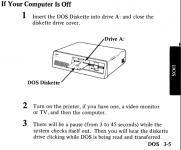gonk23
Experienced Member
Any experienced TRS-80 Model III/4 owner knows that the disk shouldn't be in the drive (with drive door down) when powering on/off the computer, otherwise the disk can become corrupted.
Does anyone know technically what's actually happening for the disk to become corrupted? Is the drive head physically/permanently damaging the disk? Or is it just random signal sent to the drive head which can randomly modify disk data? Or something else?
Are there other computers of the same era that had a similar behaviour?
Does anyone know technically what's actually happening for the disk to become corrupted? Is the drive head physically/permanently damaging the disk? Or is it just random signal sent to the drive head which can randomly modify disk data? Or something else?
Are there other computers of the same era that had a similar behaviour?





